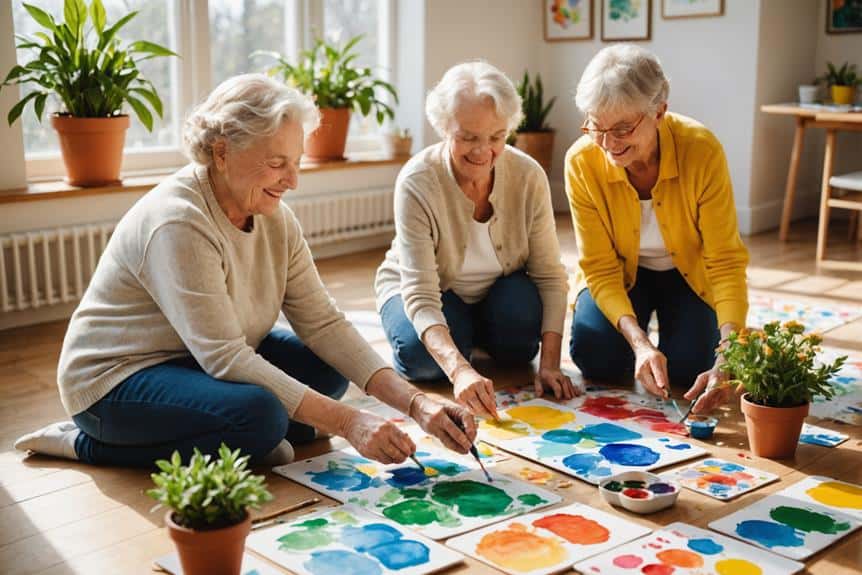Art therapy offers numerous benefits for seniors by promoting cognitive, emotional, and physical health through creative activities. Engaging in art helps you express feelings, reduce anxiety, and process grief in a safe environment. It also fosters social connections, decreasing feelings of loneliness and enhancing your sense of community. As you participate in art projects, you'll improve your physical abilities, such as flexibility and coordination, while simultaneously boosting your self-esteem. Tailored approaches guarantee that each activity meets individual needs, creating a personalized experience. Discover how art therapy can transform senior care and enrich lives even further.
Understanding Art Therapy
The American Art Therapy Association defines art therapy as an integrative mental health profession. It emphasizes the therapeutic outcomes that can arise from engaging in creative activities. As you create art, you stimulate cognitive functions and enhance neural connections, which can often weaken with age. This stimulation supports overall brain health, making art therapy not just a form of expression, but a way to keep your mind active and engaged.
Furthermore, the therapeutic process of making art can markedly reduce stress and anxiety. When you immerse yourself in creativity, you foster relaxation and mindfulness, both essential for emotional well-being. This is particularly important for seniors, who may experience feelings of isolation or sadness. By participating in art therapy, you can express your thoughts and feelings in a non-verbal way, enriching your emotional landscape and improving your quality of life. Fundamentally, art therapy offers a unique blend of creativity and healing, making it a critical component of senior care.
Cognitive and Emotional Benefits
Emotionally, art therapy serves as a powerful tool for emotional expression. It provides you with a constructive outlet to process feelings associated with grief, loss, and the notable life changes that many seniors face. By expressing your emotions through art, you can explore complex feelings in a safe and supportive environment. This process can reduce symptoms of depression and anxiety, leading to an overall improvement in your emotional well-being.
Moreover, the act of creating art fosters a sense of accomplishment and purpose. As you complete a piece, you may feel a boost in self-esteem and emotional resilience. These feelings can combat worthlessness and isolation, which are common in later years. Art therapy not only enriches your cognitive abilities but also nurtures your emotional health, making it an invaluable addition to senior care. By embracing art as a means of expression and engagement, you can meaningfully enhance your quality of life.
Social Connections Through Art
Here's how art therapy facilitates these connections:
| Benefits | Description |
|---|---|
| Community Engagement | Residents work together, building a sense of belonging. |
| Creative Expression | Sharing artistic work encourages open communication. |
| Emotional Connections | Collaborating helps deepen friendships among seniors. |
| Reducing Loneliness | Engaging in art decreases feelings of isolation. |
| Improving Well-Being | Better social interactions lead to enhanced emotional health. |
Art therapy also provides opportunities for residents to share their experiences, facilitating relationship building. This inclusive environment allows seniors to connect over shared experiences, which helps combat the stigma surrounding mental health issues in aging populations.
As you engage in creative arts, you'll notice how it leads to more meaningful interactions and a supportive atmosphere. Participating in these activities not only nurtures your artistic side but also enriches your social life, ultimately helping to improve your overall emotional well-being. So, immerse yourself in art therapy and discover the joy of connecting with others through creativity!
Enhancing Physical Abilities
Participating in these activities boosts blood flow and encourages physical engagement, which is essential for maintaining overall health and mobility as you age. When you engage in repetitive movements involved in various artistic techniques, you can strengthen your muscles and improve flexibility. This can be especially beneficial if you have conditions like arthritis, where gentle motion helps reduce stiffness.
Moreover, art therapy promotes better proprioception, which means you'll develop a greater awareness of how your body moves in space. This awareness can help prevent falls and increase your confidence in physical activities. As you immerse yourself in art, you may notice an improvement in your range of motion, allowing you to express yourself more freely.
Personalized Approaches in Care Homes
Adaptive materials play an essential role in this process. Art therapists modify their tools and methods to suit each resident's physical and cognitive abilities, ensuring everyone can participate fully in creative expression. For instance, utilizing techniques from personal care practices can enhance the overall experience by ensuring that each resident's unique needs are met. Whether it's using thicker brushes for those with limited dexterity or providing visual aids for those with cognitive challenges, these adaptations foster inclusivity and maximize engagement.
Engaging in personalized art activities empowers residents, giving them a sense of autonomy that can greatly improve their mental health. When you participate in projects that reflect your interests and experiences, it not only boosts your self-esteem but also helps build stronger social connections with others in the care home.
Ongoing communication between staff and art therapists is essential to meet each resident's evolving needs. This collaboration creates a supportive environment where personalized care and artistic expression thrive. By focusing on individual strengths and preferences, care homes can transform art therapy into a powerful tool that enhances the lives of their residents, contributing to a more fulfilling and enriched living experience.





